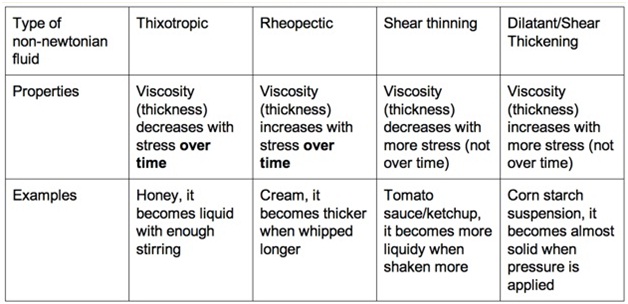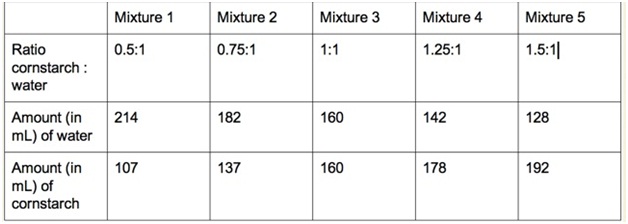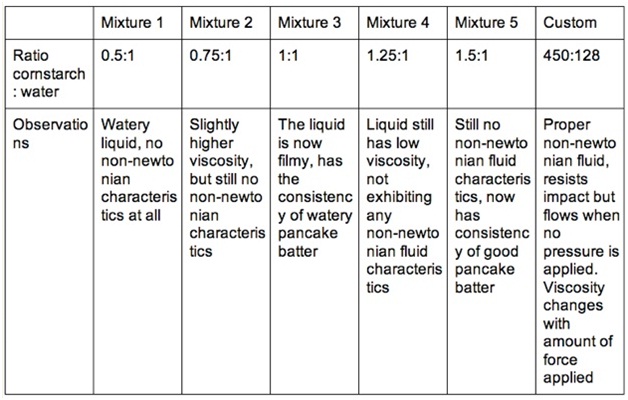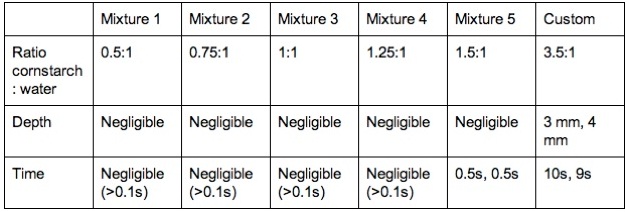





Published on Sep 16, 2023
The objective: This project is about non-Newtonian fluids and the best ratio of cornstarch and water to reach the critical pigment volume concentration. I'm testing 5 different mixtures of cornstarch and water to determine the critical PVC.
Non-newtonian fluids are fluids that don’t follow the regular laws of physics for regular fluids. These fluids can have their physical properties change because of pressure, time, or temperature. For example, some non-newtonian fluids become rock solid once pressure is applied, but become a viscous fluid when the pressure is released. Others become less viscous and become more runny when pressure is applied.
There are 4 main types, and these are:
Body armour. Dilatant fluids can be used as body armour alongside with kevlar. It absorbs force when a bullet or punch is applied, but is very free flowing (in comparison with metal or kevlar) when no pressure is applied. This makes for very flexible armour that can stop bullets just as effectively as kevlar.
The cornstarch suspension is coincidentally a dilatant, which means that it’s properties allow it to have a low viscosity when it is non-agitated, but becomes a virtual solid when under pressure because of it’s special properties.
The corn-starch and water suspension has microscopic solid particles suspended in a liquid (water). These particles are touching, but can still slip past each other, so it seems to be a liquid. But when pressure is applied quickly, the particles don’t have time to slip past each other, and because they’re big, they can’t move at all because of the force applied. Thats when the mixture feels like a solid.

At what ratio of corn starch and water will the mixture reach it’s critical PVC(Pigment Volume Concentration (when it is viscous with pressure and non-viscous without pressure)? 0.5:1, 0.75:1, 1:1, 1.25:1, 1.5:1
I think that the critical PVC will be reached at around 0.75:1 water:cornstarch because that is what most guides recommend, that or just keep on adding water/cornstarch until it ‘feels right’.
•Corn starch
•Water
•Timer
•Clear plastic bucket/bin
•Small 500g weight
1. Find the volume of the bucket/bin by filling it with water and weighing it with the original weight of the bin subtracted from the total weight. Water’s density is 1g/cm3.
2. Create 5 different mixtures at 0.5:1, 0.75:1, 1:1, 1.25:1, 1.5:1 of water to cornstarch. Each mixture should take up the same volume as the bin.
3. Take one mixture and pour it into the bin/bucket.
4. Start the timer while dropping the weight from a set height of 1 metre into the bucket, and measure the depth of the impact the weight left onto the mixture, record it.
5. Once the weight reaches the bottom of the bucket, stop the timer and record the time.
6. Repeat 4 and 5.
7. Test each of the mixtures twice.



For my project, most of the results were negligible because I didn’t have specialized equipment to test my mixtures. The custom mixture was the only mixture which exhibited non-newtonian characteristics.At a ratio close to 3.5:1, the cornstarch and water mixture will be closest to its critical PVC. I hypothesized that it would be at 0.75:1 water to cornstarch, and my hypothesis was incorrect, as the critical PVC is closer to 3.5:1 than to 1:1.333. My experiment wasn’t very successful because most of the results couldn’t be measured because of my lack of equipment.
My design wasn’t the strongest because of my lack of equipment. Additionally, I couldn’t find other ways of testing the cornstarch solutions. The cornstarch solutions I initially proposed all failed because there was no reference online or in print for a good solution for a cornstarch and water solution, so most of them said to add cornstarch or water into the mix until it ‘felt’ right. I think that my project could be used in real life for military and protection applications, specifically for body armour even though I obtained little results from this project. Non-newtonian fluids are already used in personal protection equipment along with kevlar to allow more flexibility in body armour with the flexibility of liquid/normal clothing. Next steps for further research would include researching more about good cornstarch solution to use in this experiment, since there weren’t many references to good mixtures/ratios to use.
"Non-Newtonian Fluids." Science Learning Hub RSS. The University of Waikato, 14 Apr. 2010. Web. 20 Feb. 2014.
"Q & A: Non-Newtonian Fluids II." Physics Van. The Board of Trustees at the University of Illinois, 7 June 2006. Web. 05 Mar. 2014.
Johnson, Ken. "Re: Why Does a Cornstarch and Water Slurry Harden When Compressed?" Re: Why Does a Cornstarch and Water Slurry Harden When Compressed? MadSci Network, 14 Mar. 1998. Web. 05 Mar. 2014.
"Oobleck: The Dr. Seuss Science Experiment." Instructables.com. Autodesk, n.d. Web. 12 Apr. 2014.
"Science Activity: Is This Stuff a Liquid Or a Solid? | Exploratorium."Exploratorium: The Museum of Science, Art and Human Perception. Exploratorium, n.d. Web. 5 Mar. 2014.